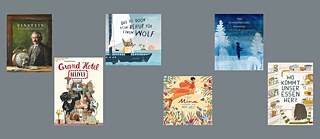New Picture Books
Animal Heroes

A she-wolf has an unusual career goal, a little dog is left behind in a hotel and a mouse takes a journey through time. These and many more stories can be discovered in newly published picture books.
By Holger Moos
Even in picture books female emancipation is a topic. Take the Grimms, a wolf family in Das ist doch kein Beruf für einen Wolf (That’s No Job for a Wolf) by Annette Feldmann and Mareike Engelke. While brother Kurt wants to study biology and become a wolf consultant, Isa dreams of a job as a ship’s captain. Drawings in muted hues on a double page show her parents’ suggestions for alternative professions. But Isa just says, “no way,” and the next morning she’s already on the express train to Hamburg. At the harbour there she meets Captain King Penguin and persuades him to take her with him on his ship. At first the crew is afraid of being eaten, but fortuitously Isa is a vegetarian. The pictures illustrating this tenderly peculiar story are perfectly harmonious. When pirates approach, the colours become more vivid to suit the dramatic situation – but luckily the crew has a shrewd and terrifying wolf on board.
In Hendrik Jonas’s Grand Hotel Bellevue, a little dog is left behind by his parents in a strange hotel during a business trip and experiences the most bizarre adventures with the staff – all of them dogs of different breeds. He thoroughly relishes his stay at the hotel where he’s no longer just the little darling, but can prove how grown-up and clever he is in the strange, run-down place. Soon he’s in demand everywhere as an aide and advisor. This large-format book gives the artist a framework and plenty of space for his large-scale collages in unusual, constantly changing sizes and perspectives. A picture book with plenty to discover inside.
LATE TO THE CHEESE FESTival
After Lindbergh (2014), Armstrong (2016) and Edison (2018), Torben Kuhlmann’s Einstein is the fourth adventure book about a little mouse who experiences an incredible story. Since she’s a day late to the cheese festival in Bern, she wonders whether time could be turned back. During her investigations, she discovers Albert Einstein’s notes in the Bern patent office where the later Nobel laureate worked from 1902 to 1909. It’s the beginning of a fantastic journey through space and time. This phenomenon is explained well to young readers, Kuhlmann’s captivating technical drawings are helpful once again.Sandra Niebuhr-Siebert is professor of language education and narrative arts. Together with the illustrator Lars Baus, she produced the picture book Mina entdeckt eine neue Welt (Mina Discovers a New World) about one of her scholarly focuses: monolingual and multilingual language acquisition processes. Little Mina is new to kindergarten. When she’s welcomed there, the only word she understands is her name so Mina prefers to remain silent at first. Mina doesn’t speak German yet, but in her mother tongue she talks a lot. The book is a very suitable introduction to conversations with children about multilingualism. “In the beginning, almost everything is strange to her, even the language of the kindergarten teacher. But Mina learns something every day, including new words, and every night she dreams of exciting encounters with the other children. Sensitively illustrated” (Deutschlandfunk list of The 7 Best in the Month of September 2020).
the childhood of a snow researcher
In Der Schneeflockensammler (The Snowflake Collector), Robert Schneider, author of the best-selling novel Schlafes Bruder (1992), tells of the childhood of the American meteorologist and photographer Wilson Bentley. From an early age, the day-dreamer was fascinated by the little things he spied along pathways, collecting stones and leaves. He “wanted to find the big in the small,” to the sorrow of his father who wanted him to become a farmer. Later, the boy became interested in snow crystals, photographed them and his father came to understand his son for the first time: “Today, Wilson, I have grasped the joy of the moment.” In their matte hues, reminiscent of snowy landscapes, Linda Wolfsgruber’s pictures reinforce the unique mood of the story.
In her picture book Wo kommt unser Essen her? Julia Dürr answers the question “where does our food come from?” The author and illustrator shows where and how the food we eat every day, such as milk, bread, fish, eggs, meat and vegetables, is produced. And she contrasts organic farming and natural animal husbandry with engineered agriculture. The picture book is as big as a hidden object book and its illustrations and texts are also reminiscent of the genre. Thanks to its clear and detailed presentation, the book also made it onto the Deutschlandfunk list of The 7 Best in the Month of September 2020

Weinheim: Beltz & Gelberg, 2020. 30 S.
ISBN: 978-3-407-75816-3
Annette Feldmann / Mareike Engelke (Illustration): Das ist doch kein Beruf für einen Wolf
München: Tulipan, 2020. 30 S.
ISBN: 978-3-86429-493-8
Hendrik Jonas: Grand Hotel Bellevue
München: Tulipan, 2020. 46 S.
ISBN: 978-3-86429-478-5
Torben Kuhlmann: Einstein
Zürich: NordSüd, 2020. 128 S.
ISBN: 978-3-314-10529-6
Sandra Niebuhr-Siebert / Lars Baus (Illustration): Mina entdeckt eine neue Welt
Hamburg: Carlsen, 2020. 48 S.
ISBN: 978-3-551-51270-3
Robert Schneider / Linda Wolfsgruber (Illustration): Der Schneeflockensammler
Wien: Jungbrunnen, 2020. 24 S.
ISBN: 978-3-7026-5946-2